
The Waffen-SS was the military branch of the Nazi Party's SS organisation. Its formations included men from Nazi Germany, along with volunteers and conscripts from both occupied and unoccupied lands.
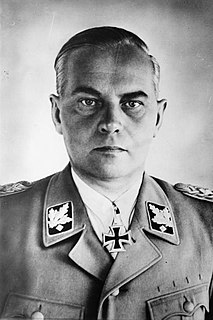
Felix Martin Julius Steiner was a German SS commander during the Nazi era. During World War II, he served in the Waffen-SS, the combat branch of the SS, and commanded several SS divisions and corps. He was awarded the Knight's Cross of the Iron Cross with Oak Leaves and Swords. Together with Paul Hausser, he contributed significantly to the development and transformation of the Waffen-SS into a combat force made up of volunteers and conscripts from both occupied and un-occupied lands.

The 11th SS Volunteer Panzergrenadier Division Nordland was a Waffen-SS division recruited from foreign volunteers and conscripts. It saw action, as part of Army Group North, in the Independent State of Croatia and on the Eastern Front during World War II.

The Flemish Legion was a collaborationist military formation recruited among Dutch-speaking volunteers from German-occupied Belgium, notably from Flanders, during World War II. It was formed in the aftermath of the German invasion of the Soviet Union and fought on the Eastern Front in the Waffen SS alongside similar formations from other parts of German-occupied Western Europe.

The 5th SS Panzer Division Wiking or SS Division Wiking was an infantry and later an armoured division among the thirty-eight Waffen-SS divisions of Nazi Germany. It was recruited from foreign volunteers in Denmark, Norway, Sweden, Finland, Estonia, the Netherlands and Belgium under the command of German officers. During World War II, the division served on the Eastern Front. It surrendered in May 1945 to the American forces in Austria.

This is a sub-article to Battle of Narva.

The Battle of Narva was a military campaign between the German Army Detachment "Narwa" and the Soviet Leningrad Front fought for possession of the strategically important Narva Isthmus on 2 February – 10 August 1944 during World War II.

This is a sub-article to Battle of Narva (1944).

The Volunteer Legion Netherlands was a collaborationist military formation recruited in the German-occupied Netherlands during World War II. It was formed in the aftermath of the German invasion of the Soviet Union and fought on the Eastern Front in the Waffen SS alongside similar formations from other parts of German-occupied Western Europe. It was the largest Dutch SS unit.
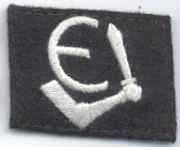
The 20th Waffen Grenadier Division of the SS was a foreign infantry division of the Waffen-SS, an armed branch of the German Nazi Party that served alongside but was never formally part of the Wehrmacht during World War II. According to some sources, the division was under Reichsführer-SS Heinrich Himmler's overall command but was not an integral part of the Schutzstaffel (SS). It was officially activated on 24 January 1944, and many of its soldiers had been members of the Estonian Legion and/or the 3rd Estonian SS Volunteer Brigade, which had been fighting as part of German forces since August 1942 and October 1943 respectively. Both of the preceding formations drew their personnel from German-occupied Estonia. Shortly after its official activation, widespread conscription within Estonia was announced by the German occupying authorities. The division was formed in Estonia around a cadre comprising the 3rd Estonian SS Volunteer Brigade, and was initially known as the 20th Estonian SS Volunteer Division.
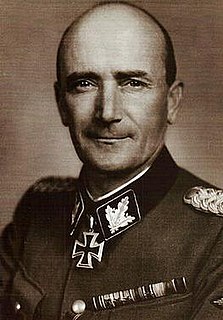
Fritz von Scholz was a high-ranking member of the Waffen-SS during World War II and a recipient of the Knight's Cross of the Iron Cross with Oak Leaves and Swords of Nazi Germany.
The IV SS Panzer Corps was a panzer corps of the Waffen-SS of Nazi Germany which saw action on the Eastern Front and in the Balkans during World War II.
The 11th SS Panzer Army was not much more than a paper army formed in February 1945 by Heinrich Himmler while he was commander of Army Group Vistula.
Army Detachment Steiner was a temporary military unit, something more than a corps but less than an army, created on paper by German dictator Adolf Hitler on 21 April 1945 during the Battle of Berlin, and placed under the command of SS-Obergruppenführer Felix Steiner. Hitler hoped that the units assigned to Steiner would be able to stage an effective counterattack against the northern pincer of the Soviet assault on Berlin, but Steiner refused to attack upon realizing the units were inadequate and understrength, being made up of some soldiers, Hitler Youth teens and emergency Air Force and Navy troops. It was the failure of this offensive that led Hitler to make his first ever declaration that Germany had lost the war.

Harald Nugiseks was an SS-Oberscharführer (Sergeant) in World War II, who served in the 20th Waffen Grenadier Division of the SS of the Waffen-SS. Nugiseks is also one of the four Estonian soldiers who received the Knight's Cross of the Iron Cross.
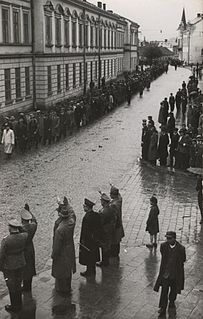
During World War II, the Waffen-SS recruited significant numbers of non-Germans, both as volunteers and conscripts. In total some 500,000 non-Germans and ethnic Germans from outside Germany, mostly from German-occupied Europe, were recruited between 1940 and 1945. The units were under the control of the SS Führungshauptamt beneath Reichsführer-SS Heinrich Himmler. Upon mobilization, the units' tactical control was given to the Oberkommando der Wehrmacht.

The Narva offensive was an operation conducted by the Soviet Leningrad Front. It was aimed at the conquest of the Narva Isthmus from the German army detachment "Narwa". At the time of the operation, Joseph Stalin, the supreme commander of the Soviet Armed Forces, was personally interested in taking Estonia, viewing it as a precondition to forcing Finland out of the war.
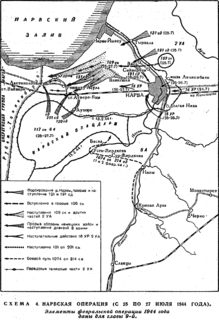
This is a sub-article to Battle of Narva (1944).

This is the order of battle that took place on April 16, 1945, in the end stages of World War II, between the German Wehrmacht and the Soviet Red Army. This battle took place before the start of the Battle of the Oder–Neisse and concluded with the Battle in Berlin. Units are listed as they were deployed from North to South before the start of the Battle of the Seelow Heights.















